There are snakes living on six of the seven continents of the world. But, have you ever wondered if there are any snakes that only live on the West Coast of North America? If so, then you’re in luck! Here, we’ll discover ten species of snake that occur only on the West Coast. Many of them are subspecies of familiar snakes, but a few just might surprise you!
Read on to learn more about ten snakes that only live on the West Coast!
1. San Diego Gophersnake

, the San Diego gophersnake, is a subspecies of the common gophersnake.
©Jerry Kirkhart from Los Osos, Calif / CC BY 2.0 – License
San Diego gophersnakes grow to between 4-5 feet long as adults. They’re nonvenomous, and completely harmless to humans. They have thick bodies characterized by a tan or orange tinted base color coupled with dark brown checkerboard markings. San Diego gophersnakes have large, round, red eyes, and short noses. They’re frequently confused with rattlesnakes, and eat mostly small mammals, birds, and bird eggs.
2. California Kingsnake

e, the California kingsnake, comes in a wide variety of colors and patterns, which can make identification difficult.
©Creeping Things/Shutterstock.com
California kingsnakes grow to 3-4 feet long and have heavy bodies with narrow heads. These snakes’ range extends a little outside of the west coast, in southern Nevada and western Arizona, but we’re not holding that against them. Their colors and markings may be mostly solid with some irregular stripes or bands, or they may be fully striped, or even striped and checkerboard patterned. The one consistent part of the California kingsnake’s appearance is the underside, which is always light. That and the base color, which is usually black or brown. These snakes eat amphibians, small mammals, lizards, and snakes, including rattlesnakes. They’re nonvenomous, and pose no threat to humans.
3. Coast Patch-nosed Snake
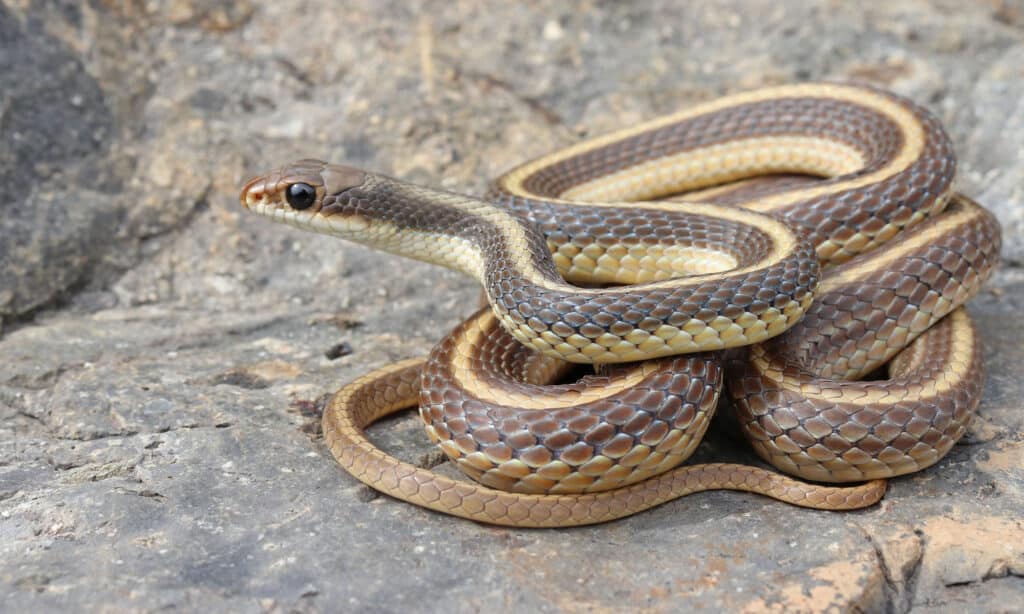
, the coast patch-nosed snake, is one of the smaller snakes that only live on the West Coast.
©Creeping Things/Shutterstock.com
These snakes grow to between 2-3 feet long as adults. They’re very fast, and typically inhabit dry areas, where their base tan color blends in well. Coast patch-nosed snakes have pale undersides, dark brown sides, and one pale stripe along the back. Their heads are characterized by round eyes and short, square noses. They’re nonvenomous, and eat lizards, birds, amphibians, and mice. Additionally, they’re strictly diurnal, which means you won’t see them at night.
4. Coast Mountain Kingsnake
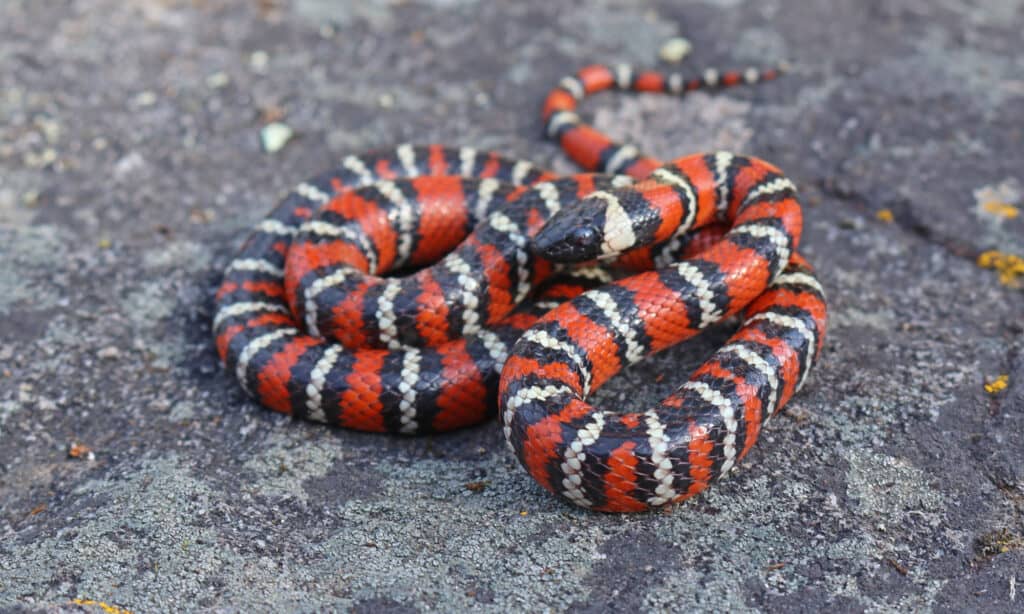
, the coast mountain kingsnake, has some of the brightest coloring of any snakes that only live on the West Coast.
©Creeping Things/Shutterstock.com
Coast mountain kingsnakes grow up to 2.5 feet long and have thin bodies with narrow heads. Their entire bodies are banded in red, black, and white stripes. But, despite their bright coloring, they’re completely venomous, and not dangerous to people. These snakes have short noses with round, black eyes. They eat small mammals, birds, smaller snakes, lizards, and amphibians. Coast mountain kingsnakes are highly secretive, and are rarely seen by humans.
5. San Bernardino Ring-necked Snake
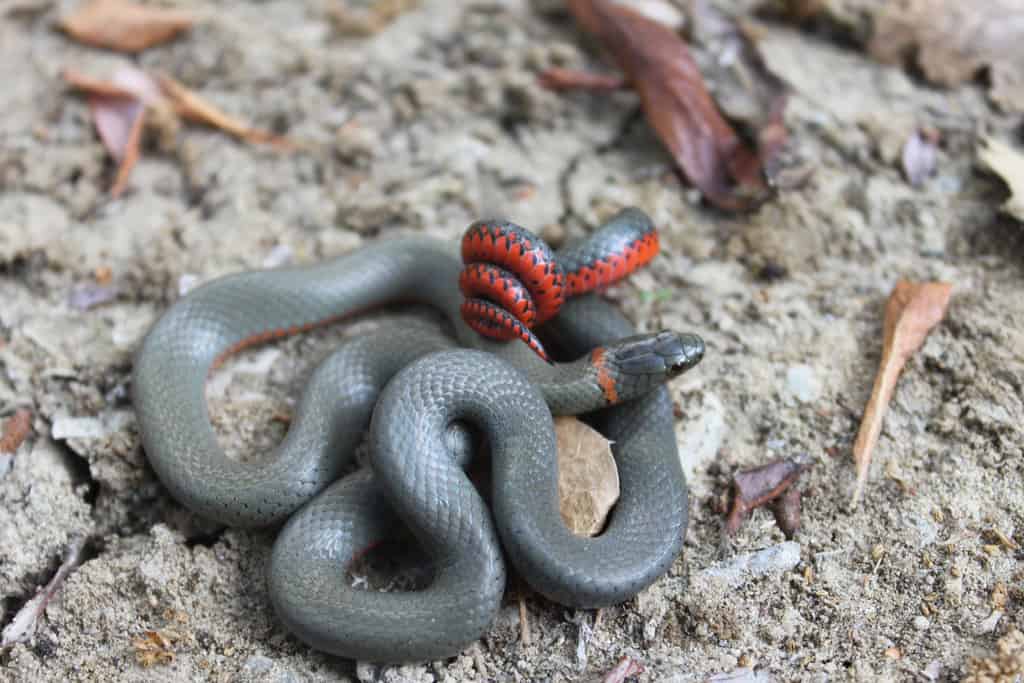
, the San Bernardino ring-necked snake, is one of the most unique snakes that only live on the West Coast.
©Mark Herr / CC BY-SA 3.0 – License
These snakes grow up to three feet long and have thin, glossy bodies. Their backs and sides are solid and unpatterned and range from gray to dark green or black. However, San Bernardino ring-necked snakes get their name from the orange ring around their necks. And, their undersides are bright yellow to orange, with distinct black spots. They’re nonvenomous, but will coil their tails up tightly when threatened. They eat worms, slugs, insects, snakes, lizards, and amphibians.
6. San Diego Ring-necked Snake
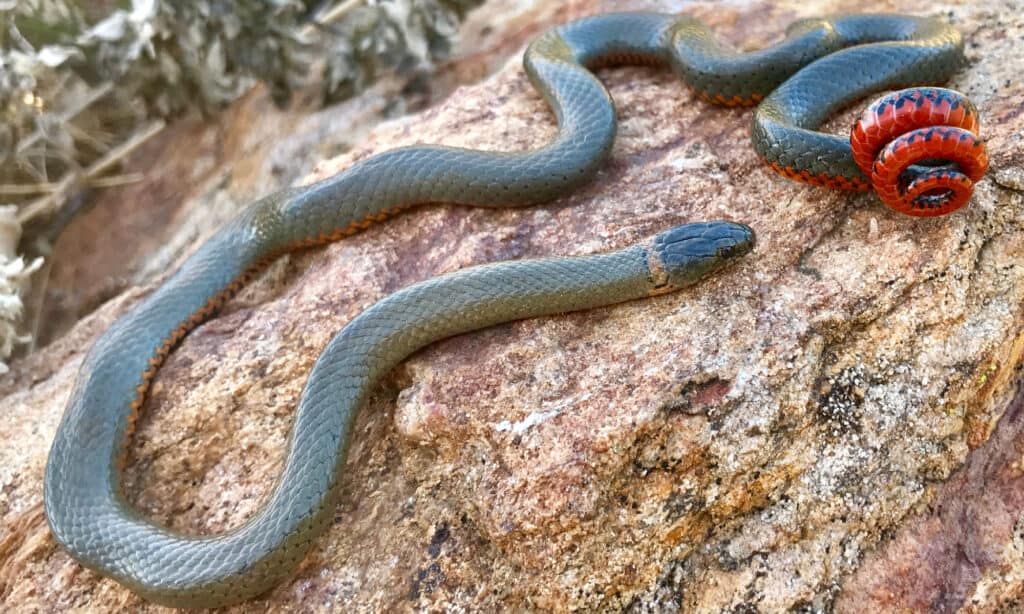
, the San Diego ring-necked snake, is very similar in appearance to the San Bernardino ring-necked snake, albeit lighter in color.
©Matt Jeppson/Shutterstock.com
San Diego ring-necked snakes are some of the brightest colored snakes that only live on the West Coast. They grow up to three feet long, and have slender, shiny bodies. They’re typically light olive green, with a single orange band around their neck. Their undersides are bright orange to red, like the San Bernardino ring-necked snake. However, the black spots on their undersides are far less distinct. These snakes eat amphibians, snakes, lizards, insects, worms, and slugs.
7. Southern Pacific Rattlesnake
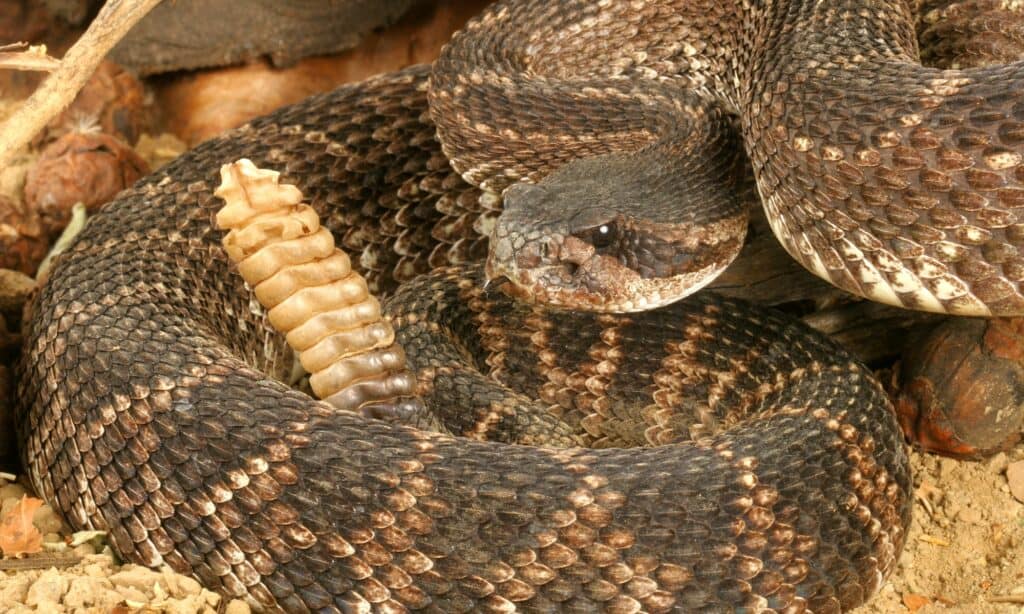
, the southern Pacific
rattlesnake
, is one of the most venomous snakes that only live on the West Coast.
©iStock.com/johnaudrey
The southern Pacific rattlesnake grows to between 3-4 feet long and has a heavy body designed for life on the ground. They have a base color of light brown, with dark brown diamond markings across the back and sides. As pit vipers, they have wide heads and folding fangs, as well as rattles on their tails. These snakes are highly venomous and eat mostly small mammals, frogs, birds, and lizards.
8. Pacific Coast Aquatic Garter Snake
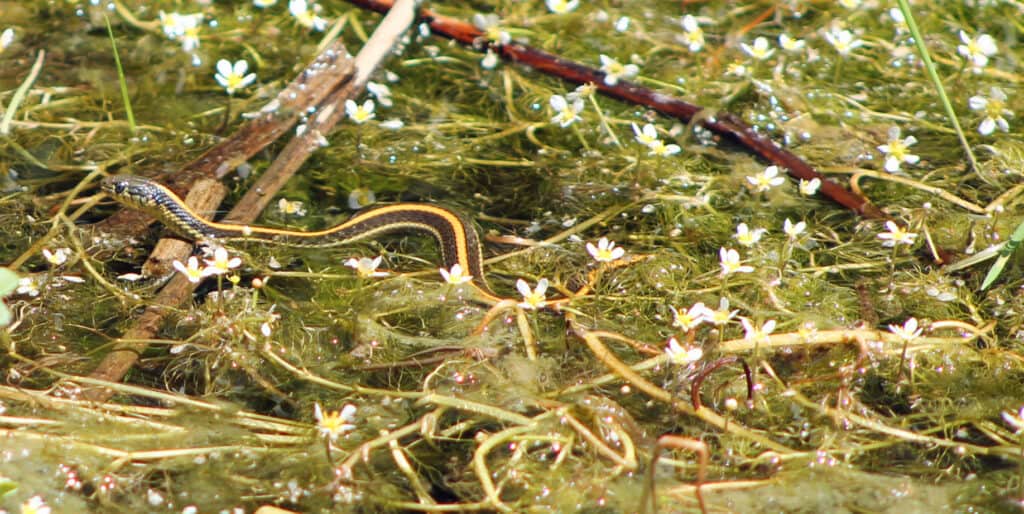
, the Pacific Coast aquatic garter snake lives in riparian areas of southwestern Oregon.
©Sarah Stierch / CC BY 4.0 – License
Pacific Coast aquatic garter snakes are some of the most water-loving snakes that only live on the West Coast. They grow to between 1.5-3 feet long and have medium-heavy bodies. Their base color is tan or light brown, with dark brown markings in a checkerboard pattern. They’re nonvenomous and eat mostly fish and amphibians. They spend most of their time in or near sources of freshwater.
9. California Lyresnake

, the California lyresnake, blends in very well with sandy or scrubland habitats.
©
California lyresnakes grow to 2-3 feet long, with thin bodies that bear a superficial resemblance to rattlesnakes. These snakes are sand-colored, with light brown markings and pale undersides. They’re nocturnal, and eat lizards, snakes, and birds.
10. Northwestern Garter Snake
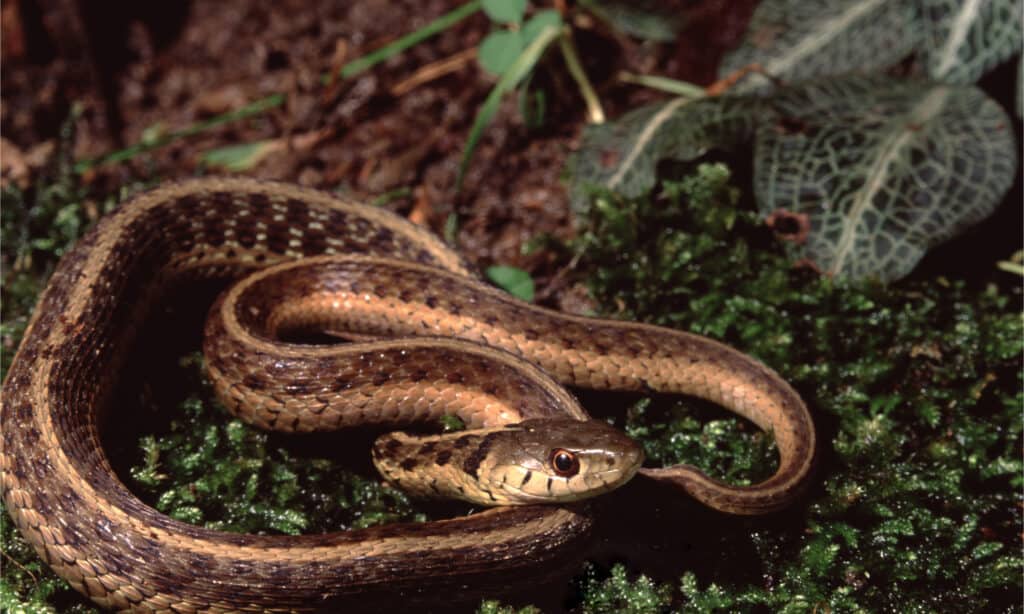
, the northwestern garter snake, has bright, distinct markings.
©Liz Weber/Shutterstock.com
These snakes are a subspecies of the common garter snake. They grow to between 2-3 feet long, and have dark brown or black bodies with yellow to orange stripes from head to tail. One stripe runs down the center of their back, with one more stripe on each side of the body. They have small heads with round, black eyes. Northwestern garter snakes are nonvenomous, and eat small mammals and amphibians.
Next Up
The photo featured at the top of this post is © iStock.com/johnaudrey
Discover the "Monster" Snake 5X Bigger than an Anaconda
Every day A-Z Animals sends out some of the most incredible facts in the world from our free newsletter. Want to discover the 10 most beautiful snakes in the world, a "snake island" where you're never more than 3 feet from danger, or a "monster" snake 5X larger than an anaconda? Then sign up right now and you'll start receiving our daily newsletter absolutely free.
Thank you for reading! Have some feedback for us? Contact the AZ Animals editorial team.






